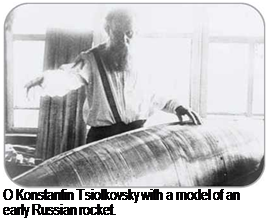Rocket
|
A |
rocket is a type of jet engine. It has three main parts: its structure, a guidance system, and a propulsion system. The structure is the basic frame of a rocket. The guidance system keeps the rocket on course. The propulsion system comprises the rocket’s engines. A rocket carries a payload-the spacecraft that is launched by the rocket. Rockets contain everything they need to work and do not need to take in air.
The History of Rockets
It is not known who built the very first rocket, but it is believed that some form
of rocket was made in China sometime before 1200, perhaps as long ago as 200 b. c.e. Early rockets were like fireworks, propelled by a mixture of chemicals called black powder. The first recorded use of rockets in war was at the Battle of Kai-Feng in 1232, when a Mongol attack on the Chinese city of Kai-Feng was fought off with the help of rockets.
In the eighteenth century, British forces came under rocket attack in India. They were so impressed with the rockets that a British artillery officer, Sir William Congreve, developed solid fuel military rockets for the British army. Congreve’s rockets were used during the Napoleonic Wars in Europe.
![]()
KONSTANTIN TSIOLKOVSKY (1857-1935)
Konstantin Tsiolkovsky, spaceflight’s earliest pioneer, was a Russian schoolteacher who wrote scientific studies of rockets and space travel. In 1898, Tsiolkovsky wrote an article entitled "Investigating Space with Rocket Devices" that presented the scientific principles of spaceflight. Over the next thirty or so years, Tsiolkovsky wrote a series of scientific and mathematical studies of rocket engines, rocket fuels, spacecraft in
 orbit, space stations, and even spacesuits. The many honors he was awarded included a lifetime pension from the Soviet state that enabled him to retire from teaching and work full-time on spaceflight. All of Tsiolkovsky’s work was theoretical. He never carried out any experiments with rockets, but rocket scientists and engineers in the Soviet Union and other countries have studied Tsiolkovsky’s work.
orbit, space stations, and even spacesuits. The many honors he was awarded included a lifetime pension from the Soviet state that enabled him to retire from teaching and work full-time on spaceflight. All of Tsiolkovsky’s work was theoretical. He never carried out any experiments with rockets, but rocket scientists and engineers in the Soviet Union and other countries have studied Tsiolkovsky’s work.
![]()
![]()

These early rockets were very inaccurate. Like firework rockets, they relied on a long stick to keep them pointing in the right direction and to stop them from tumbling. This was improved upon in 1844, when William Hale designed a rocket that spun as it flew through the air. The spinning kept it flying straight and true. These early military rockets were overtaken by advances in artillery.
In 1898, a Russian schoolteacher named Konstantin Tsiolkovsky wrote the first serious study of spaceflight using rockets. In the 1920s, rocket research flourished in several countries. In the United States, Robert H. Goddard launched the first liquid-fuel rocket. Amateur rocket scientists in Germany began developing rockets that led to the first modern rocket-propelled weapons in World War II.










